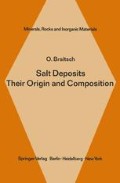Abstract
The calculation of the different models was carried out with due regard to natural occurrences. It is not to be expected, however, that these models will be closely approximated in Nature. Nevertheless, despite their manifold differences, natural salt deposits can be reduced to a few types. The classification given here is based upon purely petrographic and quantative chemical data. Other classifications, based upon geological criteria (cf. Lotze, 1957), will not be discussed here.
Access this chapter
Tax calculation will be finalised at checkout
Purchases are for personal use only
Preview
Unable to display preview. Download preview PDF.
References
The geologically interesting occurrence of Recent anhydrite has been reported from the Trucial Coast, Persian Gulf. This anhydrite is an early diagenetic mineral, developed in supratidal areas of marine lagoonal carbonate sediments, by displacement (Kinsman, 1966 ).
Kinsman, D. J. J.: Gypsum and anhydrite of recent age, Trucial Coast, Persian Gulf. Second Symposium on Salt, Vol. 1. Cleveland/Ohio. Northern Ohio Geological Society, 302–326 (1966).
Weber, 1931 incorporated Lück’s data and added further doubtful indications such as the occurrence of thenardite and in the potash layer the occurrence of carnallite relicts in vanthoffite (p. 70), and of loeweite in sylvite (p. 69). Further, being unaware of the idioblastic sequence (p. 153, 154), he assumed incorrect age relations between the minerals.
Regarding these questions see the following paper: Braitsch, O., Herrmann, A. G.: Zur Geochemie des Broms in salinaren Sedimenten, Teil II: Die Bildungstemperaturen primärer Sylvin-and Carnallit-Gesteine. Geochim. et Cosmochim. Acta 28, 1081–1109 (1964).
Secondarily formed celestite was found in the main dolomite (Hauptdolomit) of the North-German Zechstein by THEILIG and Pensold (Über das Vorkommen von Cölestin im Hauptdolomit des norddeutschen Zechsteins. Chemie der Erde 23, 215–218, 1964 ).
Rights and permissions
Copyright information
© 1971 Springer-Verlag Berlin · Heidelberg
About this chapter
Cite this chapter
Braitsch, O. (1971). Natural Salt Sequences and Physico-chemical Models. In: Salt Deposits Their Origin and Composition. Minerals, Rocks and Inorganic Materials, vol 4. Springer, Berlin, Heidelberg. https://doi.org/10.1007/978-3-642-65083-3_4
Download citation
DOI: https://doi.org/10.1007/978-3-642-65083-3_4
Publisher Name: Springer, Berlin, Heidelberg
Print ISBN: 978-3-642-65085-7
Online ISBN: 978-3-642-65083-3
eBook Packages: Springer Book Archive

